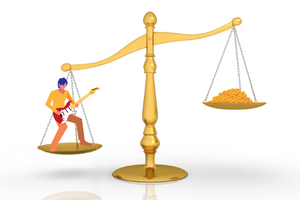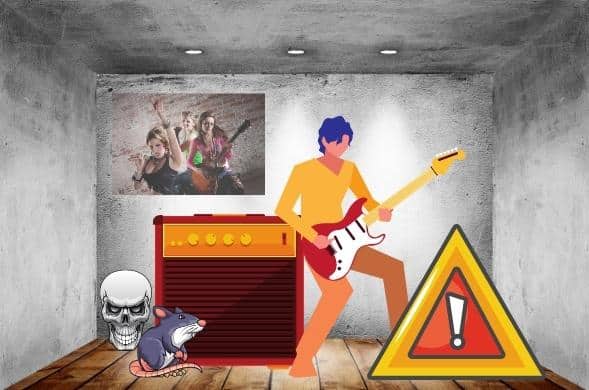Welcome to the fascinating world of electric guitars! Today, we’re diving deep into a topic that’s crucial for every guitarist to understand: “Sustain And Tone: How They Interact On An Electric Guitar.” Whether you’re a beginner just starting your musical journey or an experienced player looking to refine your sound, this guide is for you!
You can use the table of contents below to take you to the area that interests you. Click on the little box to open it, and then click on the section of the article you want to read, or you can read from start to finish if you want the full sustain and tone experience!
The Short Answer
Sustain and tone are two fundamental aspects of an electric guitar’s sound. Sustain refers to how long a note resonates, while tone is the character of that sound. They interact closely, influencing each other in various ways. Mastering the balance between them can significantly enhance your guitar playing.
Keep On Reading (Below) To Learn More
Understanding Sustain And Tone
What Is Sustain?
Sustain is the length of time a note resonates after being played before it fades into silence. It’s what allows your guitar to sing, turning a staccato note into a lyrical melody. The longer the sustain, the more expressive your playing can be.
How About Tone?
Tone, on the other hand, is the character of the sound produced by your guitar. It’s a combination of various elements, including timbre, pitch, and volume. The tone is what makes a Stratocaster sound different from a Les Paul or what makes your guitar sound uniquely yours.
The Interplay Of Sustain And Tone

Sustain and tone are like two sides of the same coin. They’re distinct concepts, but they influence each other in significant ways.
For instance, a note with a long sustain can have a rich, full tone, allowing the nuances of the sound to be heard.
Conversely, the tone of your guitar can affect its sustain. A bright, sharp tone might decay quickly, leading to shorter sustain, while a warm, full tone might resonate longer.
Mastering Sustain And Tone On Your Guitar
Techniques To Improve Sustain
Improving sustain involves both your playing technique and your equipment. Techniques like hammer-ons, pull-offs, and vibrato can enhance sustain. Additionally, the way you pick the strings, the pressure you apply on the fretboard, and even the direction of your guitar in relation to your amplifier can affect sustain.
Techniques To Refine Tone
Refining your tone is a matter of experimentation and personal preference. You can manipulate tone through your picking location, finger pressure, and use of volume/tone controls. Different playing techniques, like fingerpicking or using a slide, can also create unique tonal characteristics.
Equipment And Their Role In Sustain And Tone
Guitars
Different types of guitars can have a significant impact on both sustain and tone. Solid-body guitars, for instance, generally have longer sustain than hollow bodies. The type of wood, the guitar’s construction, and even the kind of strings can all influence the guitar’s tone.
Amplifiers
Your amplifier also plays a crucial role in shaping your guitar’s sustain and tone. Amplifier settings, especially gain and volume, can affect sustain. Similarly, the amplifier’s EQ settings can significantly influence your guitar’s tone.
Effects Pedals
Effects pedals offer a way to manipulate both sustain and tone. Compressor and overdrive pedals, for example, can increase sustain. On the other hand, EQ, overdrive, and modulation pedals can shape the tone, allowing you to create a sound that’s uniquely yours.
Comparing Sustain And Tone

| Consideration | Sustain | Tone |
|---|---|---|
| Playing Technique | Techniques such as hammer-ons, pull-offs, and vibrato can enhance sustain. | Tone can be manipulated by techniques like picking location, finger pressure, and use of volume/tone controls. |
| Electric Guitar Type | Solid-body guitars generally have longer sustain than hollow bodies. | Different types of woods (maple, alder, mahogany) produce distinct tones. |
| Effects Pedals | Compressor and overdrive pedals can increase sustain. | EQ, distortion, and modulation pedals can shape the tone. |
| Guitar Amplifier | Amplifier settings can affect sustain, especially gain and volume. | Amplifier settings, particularly EQ and gain, significantly influence tone. |
Guitarists With Distinctive Sustain And Tone
Many famous guitarists are known for their unique use of sustain and tone.
For instance, B.B. King’s “Lucille” had a distinct sustain that became a hallmark of his bluesy style.
Similarly, Brian May of Queen created a unique tone using homemade equipment, contributing to the band’s iconic sound.


Common Mistakes And How To Avoid Them
As you work towards perfecting your sustain and tone, there are some common mistakes that you might encounter.
To help you avoid these roadblocks, here are the most prevalent mistakes and tips on how to identify and avoid them.
- Sticking to the Same Techniques: Experimentation is key in music. If you’re not exploring different techniques, you’re likely missing out on a range of sounds. Try new picking styles, adjust your finger pressure, or experiment with vibrato to enhance your sustain and tone.
- Misunderstanding Your Equipment: Your amplifier and effects pedals aren’t just for show—they’re essential tools for shaping your sound. Spend time learning how different settings affect your sustain and tone. Remember, knowledge is power.
- Neglecting Guitar Maintenance: A well-maintained guitar is crucial for optimal sustain and tone. Regularly clean your guitar, change your strings, and ensure your instrument is properly set up.
By addressing these common mistakes, you’ll be well on your way to improving your sustain, refining your tone, and enhancing your overall performance.
Watch Out For These Pitfalls!

Here are a few additional points to consider when trying to optimize your sustain and tone.
- Ignoring Room Acoustics: The room you’re playing in can significantly affect your tone and sustain. Hard surfaces can cause sound to bounce around, while soft surfaces can absorb sound. Experiment with different rooms and consider using sound-absorbing materials if necessary.
- Overlooking the Importance of a Good Cable: Low-quality or damaged cables can introduce noise and degrade your tone. Invest in a good quality cable and ensure it’s in good condition.
- Overusing Effects Pedals: While effects pedals can enhance your sound, overusing them can mask your guitar’s natural tone and dynamics. Use them sparingly and always in service of the music.
- Not Resting Your Ears: It’s crucial to care for your ears when trying to shape your tone and sustain. Listening to loud music too long can lead to ear fatigue, affecting your ability to judge your sound accurately. Take regular breaks to rest your ears.
- Not Adapting to Different Guitars: Each guitar has its unique characteristics. What works for one guitar might not work for another. Always take the time to understand the specific qualities of each guitar you play.
By being mindful of these possible challenges, you can improve your comprehension of sustain and tone, resulting in a more polished and expressive guitar sound.
Key Takeaways

Here are some essential things to remember about sustain and tone.
- Sustain and tone interact closely, influencing each other in various ways.
- Mastering the balance between sustain and tone can enhance your guitar playing.
- Both your playing technique and your equipment can affect sustain and tone.
- Experimentation and understanding your equipment are key to refining your sound.
Frequently Asked Questions

Here are some of the questions I get asked about sustain and tone.
If your question does not appear here, please put it in the comments, and I will get right back to you with an answer.
What String Is Best For Sustain?
Heavier gauge strings are generally better for sustain as they vibrate longer. However, the type of material can also affect sustain, with nickel-plated steel strings often providing a good balance of tone and sustain.
Which Tonewood Has The Most Sustain?
Due to their density, hardwoods like maple and ash are often associated with good sustain. However, the guitar’s construction and other factors can also significantly influence sustain.
Does Electric Guitar Shape Affect Tone?
While the shape of an electric guitar can subtly influence the tone, it’s generally less significant than other factors like the type of pickups, the wood used, and the guitar’s construction.
Does Temperature Affect Guitar Tone?
Yes, extreme temperatures can affect guitar tone by causing the wood to expand or contract, which can alter the tension of the strings and the guitar’s overall setup. It’s best to store and play your guitar at a stable, moderate temperature to maintain a consistent tone.
Can I Improve My Guitar’s Sustain And Tone Without Buying New Equipment?
Yes, your playing technique has a significant impact on both sustain and tone. Techniques like hammer-ons, pull-offs, and vibrato can enhance sustain, and you can manipulate tone through your picking location, finger pressure, and use of volume/tone controls.
What’s The Most Important Thing To Remember About Sustain And Tone?
Experiment and find what works best for you. Everyone’s ideal sustain and tone are different, so don’t be afraid to try different techniques and equipment to find your perfect sound.
Final Thoughts

Understanding “Sustain And Tone: How They Interact On An Electric Guitar” is fundamental to mastering the music you play. It’s not just about knowing how to play the right notes; it’s also about understanding how to shape those notes to create a sound that’s uniquely yours.
Sustain and tone are like the colors on a painter’s palette. Just as a painter mixes colors to create the perfect shade, a guitarist must balance sustain and tone to create their ideal sound. By mastering this balance, you can express yourself more fully through your music, adding depth and richness that goes beyond the notes themselves.
So, what’s the next step? Pick up your guitar, start experimenting, and let your sound resonate! Experiment with different techniques and equipment, and don’t be afraid to make mistakes. Remember, every great guitarist started out as a beginner. With time, practice, and a solid understanding of sustain and tone, you can create a sound that truly represents you as a musician.

Here’s a great video from Fender that shows you the fundamental differences between clean and distorted tones and how to get them. Check it out!
What To Read Next ➡ How To Get More Sustain On Clean Guitar Tone – Pro Insider Tips!
Related Article ➡ Guitar Neck Wood Types: The Ultimate Player’s Guide!
Tell Me What You Think

Please leave a comment below if you enjoyed this article, have any questions about sustain and tone, or want to give your point of view. I will be happy to help you.
- Which guitar gives you the best sustain and tone?
- What are your favorite techniques to improve sustain and refine tone?
- Which guitar player do you think has the most iconic sustain and tone?
- What else is on your mind?



Wow, what an informative article! “Sustain And Tone: How They Interact On An Electric Guitar” really dives deep into the crucial aspects of guitar playing. I appreciate the detailed breakdown of sustain and tone, and how they influence each other. The tips on improving sustain through techniques like hammer-ons, pull-offs, and vibrato are invaluable. I also found the section on equipment, including guitars, amplifiers, and effects pedals, very helpful in understanding their role in shaping sustain and tone. The comparisons and examples of famous guitarists with distinctive sustain and tone added an extra layer of interest. The article also addresses common mistakes and provides practical advice on avoiding them. Overall, this is a must-read for any guitarist looking to enhance their sound and master the interplay between sustain and tone. Thanks for sharing this valuable resource!
Hi, Alice
Thanks so much for your comments!
Sustain has such a big impact on your final tone and vice versa.
So glad you found it helpful!
Keep On Rockin’ 🤘
Frank 🎸
Hi Frank,
First off, the article Sustain and Tone, great and engaging! Your article was full of valuable information and engaging questions while giving helpful tips. The table of the breakdown of sustain and tone is a great way to show the reader that there is a difference while playing. The
The breakdown of common mistakes is another great way that shows what guitarist does as a novice. The frequent asked question is another great way of engaging the reader.
Overall, your article is engaging in all your topics and flows well with the other topics. What I am getting from the article is I must practice and experiment until I begin a style that I like then practice some more until mastered. Another words, make those sounds flow with harmony.
How long did it take you playing with the guitar to see results?
On another note, I did see one issue. Under the title, Watch Out for These Pitfalls, the word “t” is missing “o”.
Again, great article.
Best success to you,
Homer Patrick
Hi, Homer
I appreciate your comments!
I’ve been playing the guitar every day for over 50 years, but there’s always something new to learn! 😎
Thanks for the heads-up on the typo! I fixed it. 👍
Rock On! 🤘
Frank 🎸